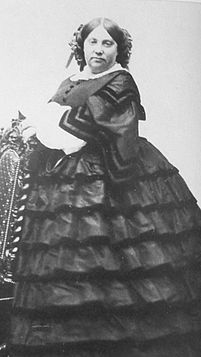Louise Marie Thérèse d'Artois
| Louise Marie Thérèse d'Artois | |||||
|---|---|---|---|---|---|

Louise Marie Thérèse d'Artois Duchess of Parma c 1860
|
|||||
| Duchess of Parma | |||||
| Consort | 19 April 1849 – 27 March 1854 | ||||
| Regent of Parma and Piacenza | |||||
| Tenure | 27 March 1854 – 9 June 1859 | ||||
| Born |
21 September 1819 Élysée Palace, Paris, France |
||||
| Died | 1 February 1864 (aged 44) Palazzo Giustinian, Venice, Lombardy-Venetia, Austrian Empire |
||||
| Burial | Kostanjevica Monastery, Nova Gorica, Slovenia | ||||
| Spouse | Charles III, Duke of Parma | ||||
| Issue |
Margherita, Duchess of Madrid Robert I, Duke of Parma Alice, Grand Duchess of Tuscany Henry, Count of Bardi |
||||
|
|||||
| House | Bourbon | ||||
| Father | Charles Ferdinand, Duke of Berry | ||||
| Mother | Carolina of Naples and Sicily | ||||
| Full name | |
|---|---|
| French: Louise Marie Thérèse d'Artois |
Louise Marie Thérèse d'Artois (Louise Marie Thérèse; 21 September 1819 – 1 February 1864) was a duchess and later a regent of Parma. She was the eldest daughter of Charles Ferdinand, Duke of Berry, younger son of King Charles X of France and his wife Carolina of Naples and Sicily, daughter of King Francis I of the Two Sicilies.
Louise's father died when she was five months old. When her grandfather abdicated in 1830, Louise joined the rest of her immediate family in exile, eventually settling in Austria. As the granddaughter of the king, Louise was a petite-fille de France. Her younger brother, Henri, Duke of Bordeaux, was King of France and of Navarre from 2 to 9 August 1830, and afterwards the Legitimist Pretender to the throne of France from 1844 to 1883.
On 10 November 1845, at Schloss Frohsdorf in Austria, Louise married Ferdinando Carlo, Hereditary Prince of Lucca, known as Charles III, Duke of Parma and Piacenza after 1849. On 17 December 1847 Empress Marie Louise died and her father-in-law succeeded as Duke Charles II of Parma. The Duchy of Lucca was incorporated in the Grand Duchy of Tuscany, and she and her husband ceased being Hereditary Prince of Lucca becoming instead Hereditary Prince of Parma.
Her father-in-law was the Duke of Parma for a few months. In March 1848 revolution broke out in Parma supported by King Charles Albert of Sardinia. Ferdinando Carlo escaped from Parma, but was taken prisoner at Cremona. He remained a prisoner at Milan for several months until the British government negotiated his release. After a brief sojourn on the island of Malta, he travelled to Naples and then Livorno where he was joined by Louise Marie Thérèse who had just given birth to their first son. Then the family sought refuge in England and Scotland.
...
Wikipedia
